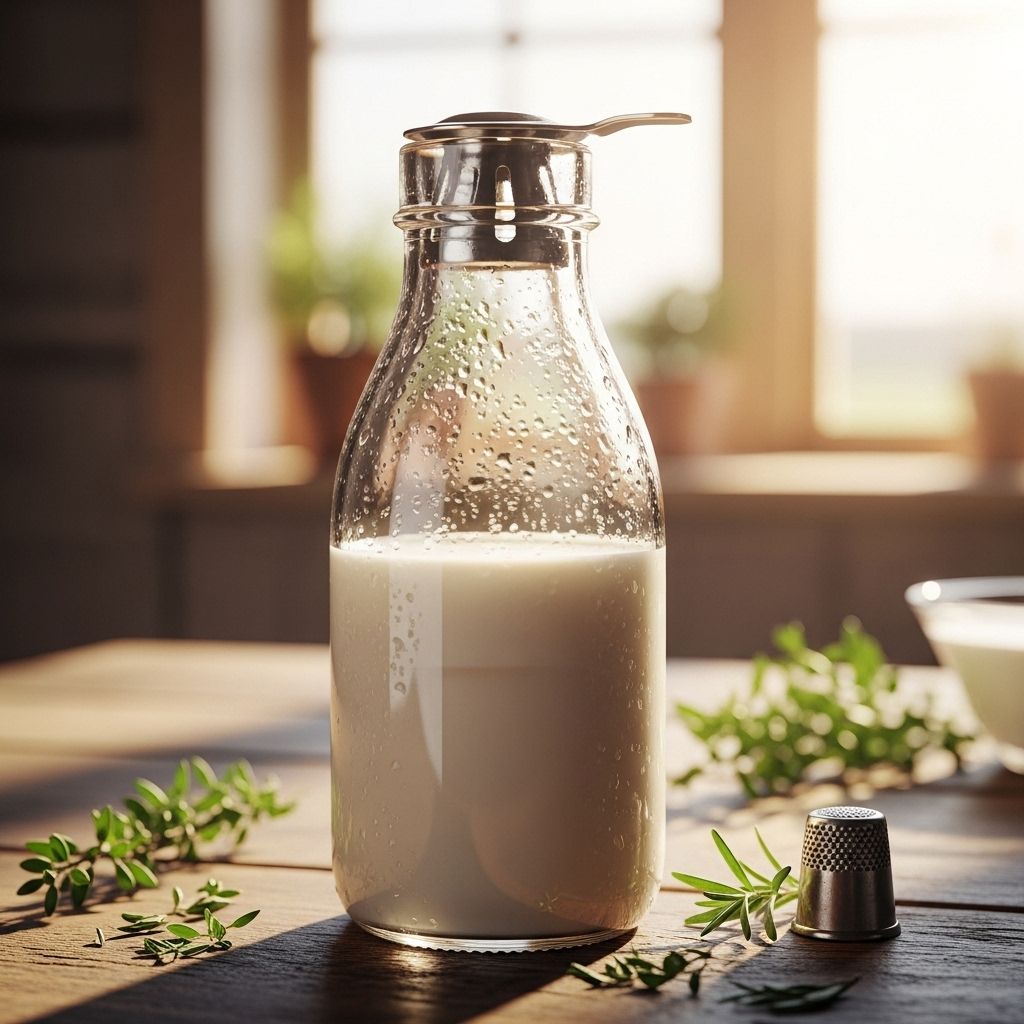Is Raw Milk Safe? Exploring the Risks, Claims, and Realities
Understand the facts about raw milk, including health risks, nutritional claims, and what experts say before you pour a glass.

Is Raw Milk Safe? What You Need to Know
Interest in raw milk—milk that hasn’t been pasteurized—has surged in recent years. Some people tout it as a more natural, nutritious alternative to conventional milk. But public health experts and major organizations warn that consuming raw milk comes with significant health risks, including the potential for serious foodborne illnesses. This article explores the facts, addresses myths, and provides expert insights to help you make an informed decision about raw milk.
What Is Raw Milk?
Raw milk refers to milk taken directly from animals such as cows, goats, or sheep that has not undergone pasteurization, the process that involves heating milk to a specific temperature to kill harmful bacteria and pathogens. Pasteurization, developed in the 19th century, dramatically reduced the prevalence of milk-borne diseases by making milk safer to drink.
- Raw milk: Unpasteurized, can harbor bacteria.
- Pasteurized milk: Heat-treated to kill pathogens, widely considered safe.
Pasteurization Explained
The pasteurization process involves heating milk to around 161°F (72°C) for at least 15 seconds or to an equivalent time-temperature combination. This kills off most harmful microbes, while retaining the milk’s nutritional profile. Contrary to some claims, pasteurization does not significantly change the nutrient content of milk.
Raw Milk vs. Pasteurized Milk: What’s the Difference?
| Feature | Raw Milk | Pasteurized Milk |
|---|---|---|
| Bacteria Present | Yes – may include harmful pathogens | No – pathogens eliminated by heat |
| Nutritional Profile | Similar to pasteurized | Similar, with minimal changes |
| Indigestible for Lactose Intolerant? | May be easier for some, but not proven | Can be difficult for lactose-intolerant individuals |
| Probiotics Present | Some, but risk of pathogens outweighs potential benefits | Very limited due to heat treatment |
| Food Safety Regulatory Status (U.S.) | Sales restricted/banned in many states | Permitted for public sale |
Why Do People Drink Raw Milk?
Proponents of raw milk claim it is more nutritious and contains beneficial probiotics and enzymes that are destroyed by pasteurization. They also believe that raw milk is better for digestion, can alleviate allergies, and reduces lactose intolerance symptoms.
- Belief that it is closer to its “natural state”
- Claims of improved taste and digestibility
- Perception that it supports local farmers and traditional practices
- Suggestions that it may contain beneficial bacteria lacking in pasteurized milk
However, major health organizations—including the FDA, CDC, and American Academy of Pediatrics—stress that these claims are not supported by high-quality evidence and do not outweigh the risks associated with unpasteurized milk.
Understanding the Health Risks of Raw Milk
Raw milk can harbor a range of disease-causing microorganisms. Even with careful animal husbandry and sanitary milking practices, there is no way to guarantee raw milk is free of harmful bacteria like Salmonella, E. coli, Listeria, and Campylobacter.
Key Risks Associated with Raw Milk
- Bacterial Contamination: Even healthy animals can carry germs that contaminate milk at the source.
- Foodborne Diseases: Raw milk is a known source for bacterial infections, including severe forms such as hemolytic uremic syndrome (linked to E. coli) and listeriosis (caused by Listeria), which can have serious or fatal consequences.
- Vulnerable Populations: Young children, the elderly, pregnant women, and immunocompromised individuals are at highest risk for life-threatening illness from pathogens found in raw milk.
According to the CDC, from 1998 to 2018, raw milk consumption was linked to at least 202 outbreaks, resulting in 2,645 illnesses and 228 hospitalizations. Foodborne illnesses related to raw milk are likely underreported, so the real numbers may be higher.
Common Bacteria Found in Raw Milk
- Salmonella: Causes diarrhea, fever, and abdominal cramps.
- E. coli: Ranges from mild to severe; some types can lead to kidney failure.
- Listeria: Particularly dangerous for pregnant women as it can lead to miscarriage, stillbirth, or newborn death.
- Campylobacter: Causes gastrointestinal illness, and can result in long-term complications like arthritis.
Raw Milk: Myths vs. Facts
- Myth: Raw milk is more nutritious than pasteurized milk.
- Fact: Scientific evidence shows both versions contain similar levels of vitamins, minerals, and proteins. Pasteurization does not destroy important nutrients.
- Myth: Raw milk is a good source of beneficial probiotics.
- Fact: While raw milk does have bacteria, these are not proven probiotic strains and can be dangerous pathogens. Most beneficial probiotics come from fermented foods.
- Myth: Raw milk reduces lactose intolerance.
- Fact: Some raw milk drinkers claim improved tolerance, but there is no high-quality scientific evidence to support that raw milk is easier for those with lactose intolerance.
What Experts and Agencies Say
Virtually all public health experts and organizations in the United States, including the FDA, CDC, and American Academy of Pediatrics, strongly advise against drinking raw milk due to its preventable and potentially severe health risks.
“Pasteurized milk provides all the nutritional benefits of milk while eliminating harmful bacteria that can cause severe illness, particularly in young children. Raw milk, on the other hand, poses unnecessary health risks and has been linked to serious infections and hospitalizations.”
— Dr. Robert Frenck, American Academy of Pediatrics
Vulnerable Populations at Increased Risk
- Children under 5 years old
- Pregnant women and unborn children
- Adults over 65 years old
- People with weakened immune systems (such as cancer patients, those with HIV/AIDS, diabetes, or immune disorders)
For these groups, the consequences of infection can be severe, including kidney failure, miscarriages, chronic health problems, or even death.
Are There Any Benefits to Raw Milk?
Advocates argue that raw milk has health-promoting enzymes, a richer flavor, and possibly probiotic bacteria. A few scientific studies have suggested potential reductions in allergies for children raised on farms who drank raw milk. However, these findings are preliminary, do not account for other farm exposures, and are not seen as conclusive by mainstream health authorities.
Some raw milk supporters also claim that carefully produced raw milk—such as that from small, hygienic, and frequently tested farms—is lower risk. But experts agree that hygienic production cannot fully eliminate harmful pathogens, and there is always a risk that raw milk contains invisible, dangerous bacteria.
Is Raw Milk Legal?
Regulations around raw milk vary widely by state in the U.S.:
- Some states ban the sale of raw milk entirely.
- Others allow sales directly from farms, at retail outlets, or only for pet consumption.
- Federal law prohibits interstate sales of raw milk for direct human consumption.
Consumers should be aware of their own state’s laws before sourcing or purchasing raw milk products.
How to Minimize Risks If You Choose to Consume Raw Milk
- Purchase from producers who test their animals and milk, and who employ rigorous cleanliness standards.
- Store milk properly and keep it refrigerated at all times.
- Infants, seniors, pregnant women, and the immunocompromised should avoid raw milk entirely.
- Consider using pasteurized alternatives to obtain similar nutrition and taste with lower risk.
Summary: What’s the Bottom Line?
- Raw milk carries significant health risks, particularly for vulnerable groups.
- Pasteurized milk is equally nutritious and much safer.
- The potential benefits of raw milk remain unproven and do not outweigh the risks.
- Expert consensus: Avoid raw milk to protect yourself and your family from preventable illness.
Frequently Asked Questions (FAQs) About Raw Milk Safety
Q: What bacteria can be found in raw milk?
A: Harmful pathogens—including Salmonella, E. coli, Listeria, and Campylobacter—can be present in raw milk and are responsible for most of its health risks.
Q: Does pasteurization significantly reduce milk’s nutritional value?
A: No. Pasteurization only minimally affects key nutrients like calcium, protein, and vitamin D. Both raw and pasteurized milk provide similar nutritional benefits.
Q: Is it legal to buy raw milk in the U.S.?
A: It depends on your state. Selling raw milk is banned in some states, while others permit farm sales directly to consumers. Federal law bans interstate sales for human consumption.
Q: Do any groups especially need to avoid raw milk?
A: Yes. Children, pregnant women, older adults, and anyone with a weakened immune system should never consume raw milk due to their higher risk of severe illness.
Q: Can careful farming practices make raw milk safe?
A: Good hygiene reduces but cannot eliminate the risk. Even animals appearing healthy can shed dangerous bacteria; negative testing cannot guarantee safety in every batch.
Final Thoughts
While interest in “natural” foods has driven curiosity about raw milk, the overwhelming expert consensus is that the risks greatly outweigh any alleged benefits. Choosing pasteurized milk allows you to enjoy milk’s nutrition while minimizing the chance of serious, preventable foodborne illness. If you’re seeking probiotics or special nutrients, consider safer, pasteurized fermented products such as yogurt and kefir as alternatives.
References
- https://www.brownhealth.org/be-well/raw-milk-101-benefits-risks-and-what-consider
- https://www.fda.gov/food/buy-store-serve-safe-food/dangers-raw-milk-unpasteurized-milk-can-pose-serious-health-risk
- https://www.aap.org/en/news-room/fact-checked/fact-checked-the-dangers-of-drinking-raw-milk/
- https://www.cdc.gov/food-safety/foods/raw-milk.html
- https://www.rawmilkinstitute.org/updates/letter-to-medical-professionals-about-raw-milk
- https://pmc.ncbi.nlm.nih.gov/articles/PMC4890836/
- https://www.fda.gov/food/buy-store-serve-safe-food/raw-milk-misconceptions-and-danger-raw-milk-consumption
- https://www.ama-assn.org/public-health/infectious-diseases/raw-milk-questions-patients-may-have-and-how-answer
- https://dph.illinois.gov/topics-services/diseases-and-conditions/respiratory-disease/diseases/influenza/h5n1/raw-milk.html
- https://pmc.ncbi.nlm.nih.gov/articles/PMC7019599/
Read full bio of medha deb












